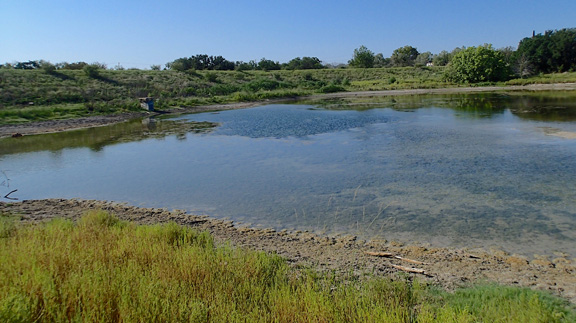Farm & Ranch
[AgriLife Extension] Brush control no help for water supplies, lake sedimentation

Writer: Kay Ledbetter, 806-677-5608, [email protected]
Contact: Dr. Bradford Wilcox, 979-458-1899, [email protected]
Dr. Matthew Berg, 979-450-9671, [email protected]
COLLEGE STATION – Brush control has many benefits, including restoration of wildlife habitat and potentially improved livestock grazing, but water supply enhancement should not necessarily be considered one of them.
That’s the conclusion of a new Texas A&M AgriLife Research study published in Hydrology and Earth System Sciences, which looked at 85 years of data and investigated impacts of dramatic landscape change on rangeland water resources in Central Texas.
The study found no change in stream flows despite striking changes in brush cover and 80 percent reduction in cropland area, said Dr. Matthew Berg, who was an AgriLife Research postdoctoral research associate in the Texas A&M University ecosystem science and management department and is now with Artesian Insights in Houston.
The study was completed under the direction of Dr. Bradford Wilcox, AgriLife Research ecohydrologist in the department of ecosystem science and management. Collaboration was received from the Texas A&M department of geology and geophysics as well as The Water Institute of the Gulf and Tulane University department of earth and environmental sciences, both in Louisiana.
Wilcox said the study findings challenge simplistic assumptions about streamflow and sediment yield in dynamic rangelands.
“Determining the role of these landscapes in meeting growing water resource demands requires a creative approach,” he said. “Matt’s study determined land managers might need to reconsider some of their practices.
“His findings are important because they show an integration of multiple techniques with historical information will enable a more complete understanding of rangeland processes and lead to more informed water planning,” Wilcox said.
Berg said part of the problem is previous research has been based on models or small-scale studies that have trouble scaling up to contexts that matter for state water planning.
“We know some regions in the state include brush control as a key water supply strategy, theorizing that woody plant species use more water than grasses,” Berg said. “But they will likely be disappointed.
“Any ‘new’ water earmarked for future use is water we already have. It is already in the system anyway, not additional supplies. If that is counted toward future needs, someone is missing out.”
Berg said there is also a potential for a double-whammy. Not only will there be a lack of increase in water supplies but there will be a loss of reservoir volume due to erosion and sedimentation from the brush control projects.
“Our study found that lake-filling sediment deposited much faster before 1963, when agricultural conservation practices were largely absent and brush clearing was more widespread,” he said. “We even found there has been a tiny uptick in stream flows since the 1970s despite a 100 percent increase in brush cover.”
Berg said surprisingly they found drought had very little impact on lake sedimentation rates in recent decades; it generally was in direct correlation to the amount of brush clearing and improper agricultural practices from previous decades.
Dependable land stewardship solutions for water supplies should focus on management practices that keep water in place, reduce erosion and remobilize sediments that threaten storage in reservoirs, Wilcox said.
The complete study can be found at http://bit.ly/29sopwP under the title “Contrasting watershed-scale trends in runoff and sediment yield complicate rangeland water resources planning.”
-30-
Find more stories, photos, videos and audio at http://today.agrilife.org
Farm & Ranch
Hazards of Backyard Poultry

By Barry Whitworth, DVM
Having backyard poultry is a popular agriculture enterprise. According to the United States Department of Agriculture, 0.8 percent of all households in the United States have chickens. People keep chickens for a variety of reasons with table eggs being one of the more common reasons.
Unfortunately, some of these poultry producers are not aware of the hazards that come with keeping poultry because many times they carry pathogens but appear healthy.
Chickens are carriers of several zoonotic diseases. These are diseases that can be passed from animals to humans. According to a recent survey in Pennsylvania, a majority of backyard poultry producers were aware of the dangers of avian influenza. However, this study also revealed that far fewer producers were aware of the risk of possible exposure to Salmonella and Campylobacter.
The lack of knowledge about the hazards of raising poultry likely contributes to the continued issues of Salmonella outbreaks associated with backyard poultry. In 2023, the Centers for Disease Control and Prevention reported 1,072 illnesses of Salmonella linked to backyard poultry, and 272 of those patients required hospitalization. Oklahoma reported 43 individuals with the disease.
To read more, pick up a copy of the April issue of NTFR magazine. To subscribe by mail, call 940-872-5922.
Farm & Ranch
Ag Elsewhere: Wyoming

By Tressa Lawrence
Babies are tucked away in every nook and cranny. Many ranchers across Wyoming have baby animals popping up all over this time of year.
Farm & Ranch
Ag Elsewhere: Montana

By Lindsey Monk
Another load of grain in to keep feeding the calves until the green grass can really start popping.
-

 Country Lifestyles1 year ago
Country Lifestyles1 year agoScott & Stacey Schumacher: A Growth Mindset
-

 Equine7 months ago
Equine7 months agoThe Will to Win
-

 Country Lifestyles7 years ago
Country Lifestyles7 years agoStyle Your Profile – What your style cowboy hat says about you and new trends in 2017
-

 Country Lifestyles4 years ago
Country Lifestyles4 years agoAmber Crawford, Breakaway Roper
-

 HOME7 years ago
HOME7 years agoGrazing North Texas – Wilman Lovegrass
-

 Country Lifestyles7 years ago
Country Lifestyles7 years agoDecember 2016 Profile, Rusty Riddle – The Riddle Way
-

 Country Lifestyles8 years ago
Country Lifestyles8 years agoJune 2016 Profile – The man behind the mic: Bob Tallman
-

 Outdoor9 years ago
Outdoor9 years agoButtercup or Primrose?






